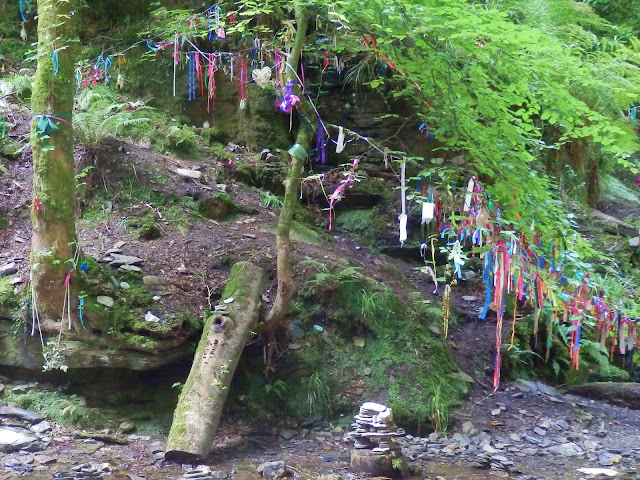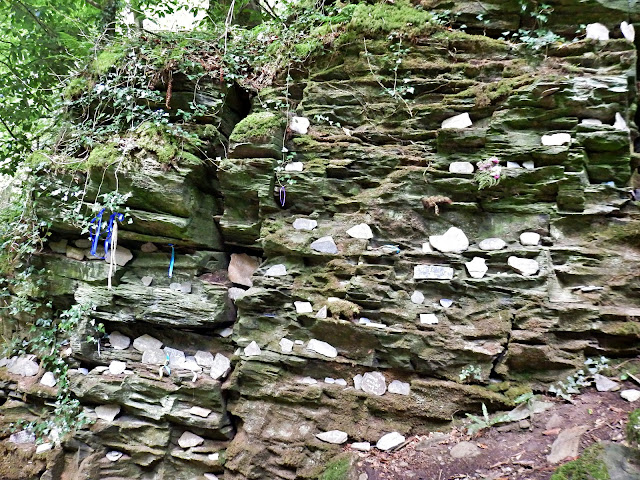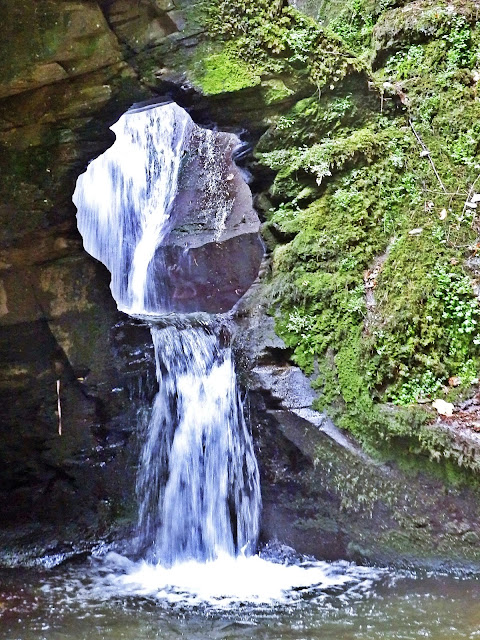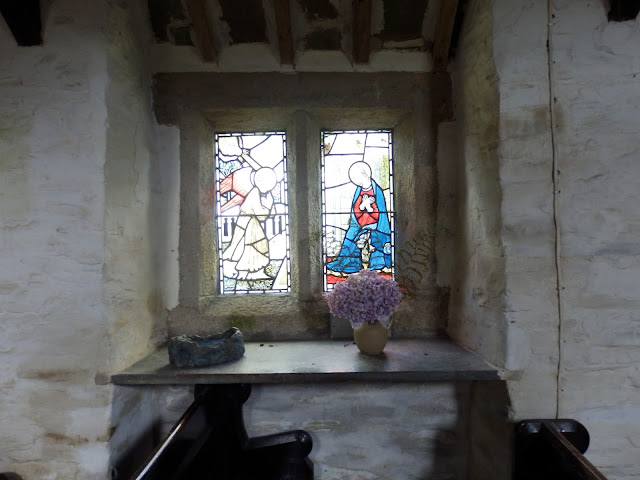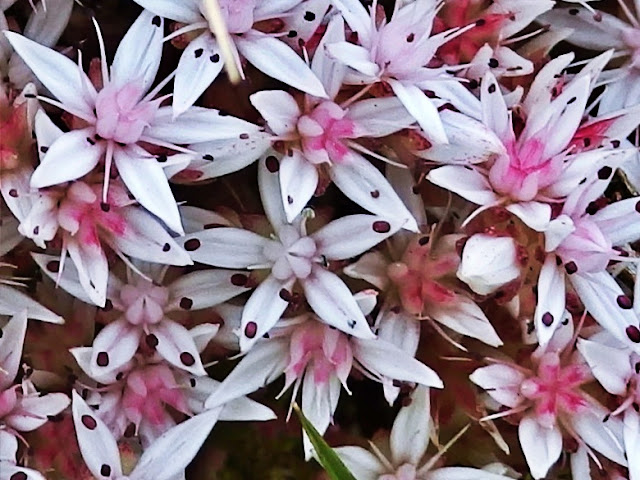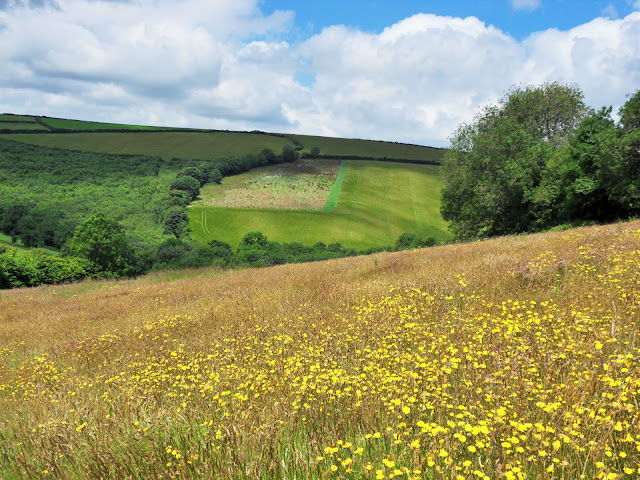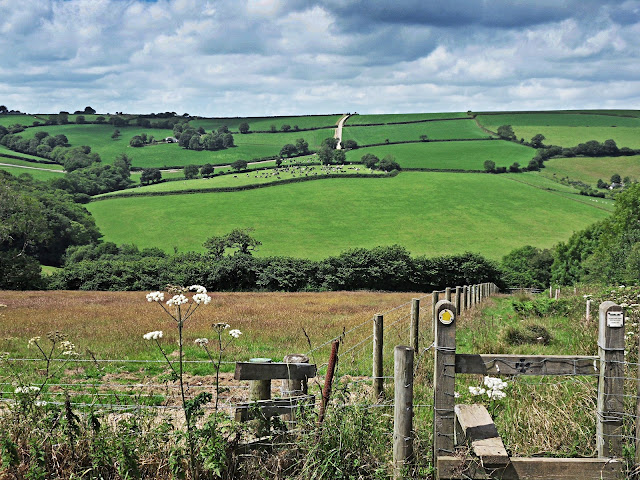Monday, 24 June 2019
The Magical, Mysterious Waterfall at St.Nectan's Kieve, Cornwall
My previous post was about St.Piran's Holy Well and St. Piran's Church. From the same area - Trethevey - there is a walk to what is often known as St.Nectan's Waterfall. This is a quite magical and mysterious place to visit. The photo above shows the waterfall.
First though it's a walk alongside a couple of cottages.
And after a short while, the sea on Cornwall's north coast comes into view across the fields.
The path becomes wooded and St.Nectan's Glen, with it's waterfall, is at the top of the valley.
The path through the woods continues ...
... until the waterfall is reached - well, nearly. Unfortunately this is on private ground so there is a charge to continue to the waterfall itself (see current prices here).
At last we are at St.Nectan's waterfall.
To be correct though we are actually at St.Nectan's Kieve (Kieve being the Cornish word for wash tub!)
It's an idyllic, almost spiritual place, with a touch of magic thrown in. The waterfall cascades about 60 feet. It has been an inspiration for many writers and artists, especially in the 18th and 19th centuries.
Charles Dickens visited the site with his friend the artist, Daniel Maclise. This resulted is the romanticised painting as seen below, which was exhibited at the Royal Academy in 1843.
The woman in the painting is believed to be Georgina Hogarth, Dickens sister-in-law.
All around the Kieve there are ribbons on trees with messages left by visitors.
The area can get a little busy at the height of the tourist season - my photos were snapped when all was reasonably quiet.
As well as all of the ribbons there are stone messages and thoughts left by visitors.
I think it's a lovely spot, the hole in the rock makes the waterfall a bit special.
There is a money tree as well - lots of coins pushed into a tree trunk. The reason for this is as per my blog post The Cornish Piskies and the Money Tree.
To quote the owners about the Kieve: "this is a place where animals and birds play amid a mysticism of fairies, piskies, serenaded by the wonderful sound of bird song".
To finish the post there is a mystery or perhaps a legend!
It is said that shortly before his death St.Nectan threw his silver chapel bell into the waterfall. On his death his body and other treasures were placed in a chest beneath the rocks in the kieve.
The years passed until a group of miners attempted to blast their way through to the treasure, but this proved unsuccessful.
As they were leaving they heard the ringing of a bell and then came an invisible voice which said, "The child is not yet born who shall recover the treasure."
Saturday, 22 June 2019
The Ancient St Piran's Holy Well and St Piran's Church, Trethevy, Cornwall
In my previous post I mentioned the rock carvings at Rocky Valley. In the same area of Trethevy are also other old places of interest.
In the photo above, for instance, is St. Piran's Holy Well. It's thought to have been used, as such, for several centuries.
The present structure of the well was recorded in 1880 and was built around a slate support for an adjoining open fronted cart hut. Until recently water was drawn by a hand pump at the back of the building.
St. Piran is, of course, the patron saint of Cornwall and close by to the well is St. Piran's Church - photo below.
The church was first recorded in 1457 when the vicar at nearby Trintagel was granted a licence to celebrate mass here.
The church was probably used as such until the early 1700s. A gravestone was found dated 1707.
For many years the church was used as a farm building, until 1941 when it was restored for use as a mission church.
A lot of the church has been, perhaps, over restored and most of the medieval features have unfortunately been lost.
All within the same area is also St. Nectan's Kieve and Waterfall, which I'll mention in a future post.
When following the path that leads to the magical waterfall you pass a granite Roman Milestone as shown in the photo below. The pillar has been damaged - as it was used as a gate post for many years!
A badly worn inscription reads:
IMP C DOMINI NGAL LO ET VOLUS
Translated this says "The Emperors, Caesars our Lords Gallus and Volusianus". (AD25-253)
Will continue in the same area with St.Nectan's Waterfall in my next post.
See also:
Early Bronze Age Rock Carvings at Rocky Valley, Cornwall
Thursday, 20 June 2019
Early Bronze Age Rock Carvings at Rocky Valley, Cornwall
Something a bit different today. The two rock face carvings - photos above and below - are from Rocky Valley, Cornwall, quite near to the well known village of Tintagel on Cornwall's North Coast.
The carvings were discovered in 1948 and there is an official sign which states:
ROCKY VALLEY ROCK CARVINGS
Labyrinth Pattern Carvings
probably of the Early Bronze Age (1800-1400BC)
This monument is protected under
the Ancient Monuments Act 1913
Similar patterned carvings have been found in various parts of the world such as in Crete and Galacia, Spain. Below is a photo, from Wikipedia showing a similar design in Galacia.
All in all sounds convincing but there are those who would spoil the story by reaching a different conclusion, Some question the carvings and say they may only be 300 years old maximum.
The main reason to doubt the age of the carvings is the fact that there aren't any similar examples in south-west England.
Personally I'd like to believe that the carvings are thousands of years old. Many others seem to to agree as they have left coins, ribbons with messages, candles and so on nearby. Very New Age - if that term still applies nowadays.
Above: a similar carving in Galacia, Spain
Tuesday, 18 June 2019
15 Photos of Flowers in Cornwall, England

A few flower photos I have snapped in the month of June in Cornwall, England. The one above is from my own garden and the following two were taken from the cliff path leading to the lovely village of Polperro.
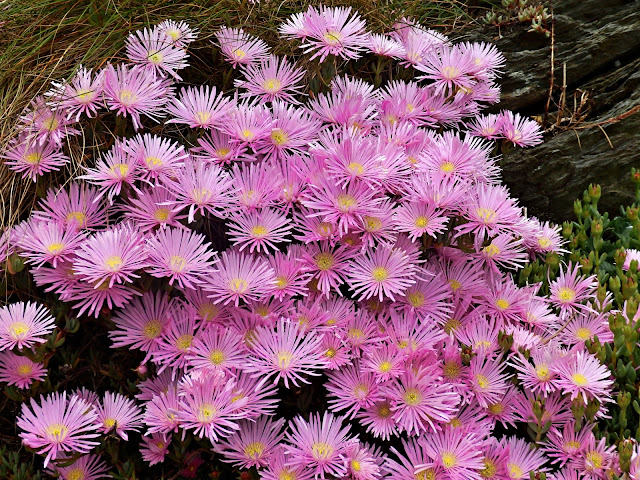
The next four flower photos were snapped at Cornwall's Lost Gardens of Heligan.
Now five photos of flowers seen while walking in Cornwall walking.
 |
 |
 |
And below another photo from the Lost Gardens of Heligan - this is their Sundial Garden.
Next we have a field of wild flowers.
Finally, looks like there will be some blackberries once the flowers have dropped.
You may also like:
(1) Growing Apple Tree From A Pip - Plus Cornwall's Eden Project
(2) The Lost Gardens of Heligan : 8 Photos of Plants, Jungle and Farm Animals
(3) Trelissick House and Gardens With Stunning Maritime Views
Sunday, 16 June 2019
The Government Communications Headquarters Situated on Beautiful North Cornwall Cliffs
A few weeks back we were walking along the north Cornwall coastal path when we came to quite a climb! See photo above - there were many steps that seemed to go on and on. But such is life!
As we climbed we saw the unexpected - lots of satellite dishes! Not having walked this particular stretch of coast before I wasn't sure what all of this was. Then I remembered the GCHQ Bude.
I have now read a little about this. I discovered that there are actually 21 satellite antennas.
This is one branch of the (UK) Government Communications Headquarters.
Its agents gather information by secretly listening in to phone conversations, satellite signals and reading e-mails. They decode messages, monitor communication between people, and ensure that the Government's secrets remain secret.
According to Wikipedia the antennae are generally orientated towards satellites of the INTELSAT , Intersputnik, and INMARSAT communications networks over the Atlantic Ocean, Africa and the Indian Ocean, as well as towards the Middle East and mainland Europe.
Between 2011 and 2013, a torus antenna was installed, which is capable of receiving signals of up to thirty-five satellites simultaneously.
From its inception, the station has been an Anglo-American co-operative project. It was the United States NSA who paid for most of the infrastructure and the technology.
So, be careful what you say, you never know who might be listening ...
Friday, 14 June 2019
Walking at Golant, Cornwall
I like walking, as you may have gathered from my posts - and not necessarily following a pre-planned route. It's sometimes just nice to walk.
The photos today are of such a walk starting at Golant, Cornwall. We parked the car alongside the river. The tide was out as you can see from the photo below.
We passed the Fishermans Arms pub and headed for a footpath.
The yellow arrow on the sign indicated that this is a Public Footpath and the black cross shows that this is part of the Saints' Way.
We walked through the woods ...
... with glimpses of the River Fowey.
The path wiggled about but was clear of any hazards - not that we expected any!
The sunshine made it's way through the tree tops casting bright patches on the grass.
The trees gradually disappeared and the fields opened up before us.
Wild flowers tinted the fields.
And then ... well, I think this is my favourite view - photo below.
A few cattle joined us as we walked until ...
... we reached St.Sampson's Church.
There was a lovely view from the churchyard. Oh yes, and the church has it's own Holy Well.
It was then downhill to the river and back to our car.
All in all very pleasant and uplifting!
You may also like:
A Walk With Stunning Views at Tintagel, Cornwall - 20 Photos
or / and
33 Photos: Circular Walk Based On Gover Valley, St.Austell
Subscribe to:
Posts (Atom)
FEATURED POST
SPIT BEACH CORNWALL
The strange photo above is the start of a path to Spit Beach , which is off the normal tourist trail. It has a free small car park. Below sh...











